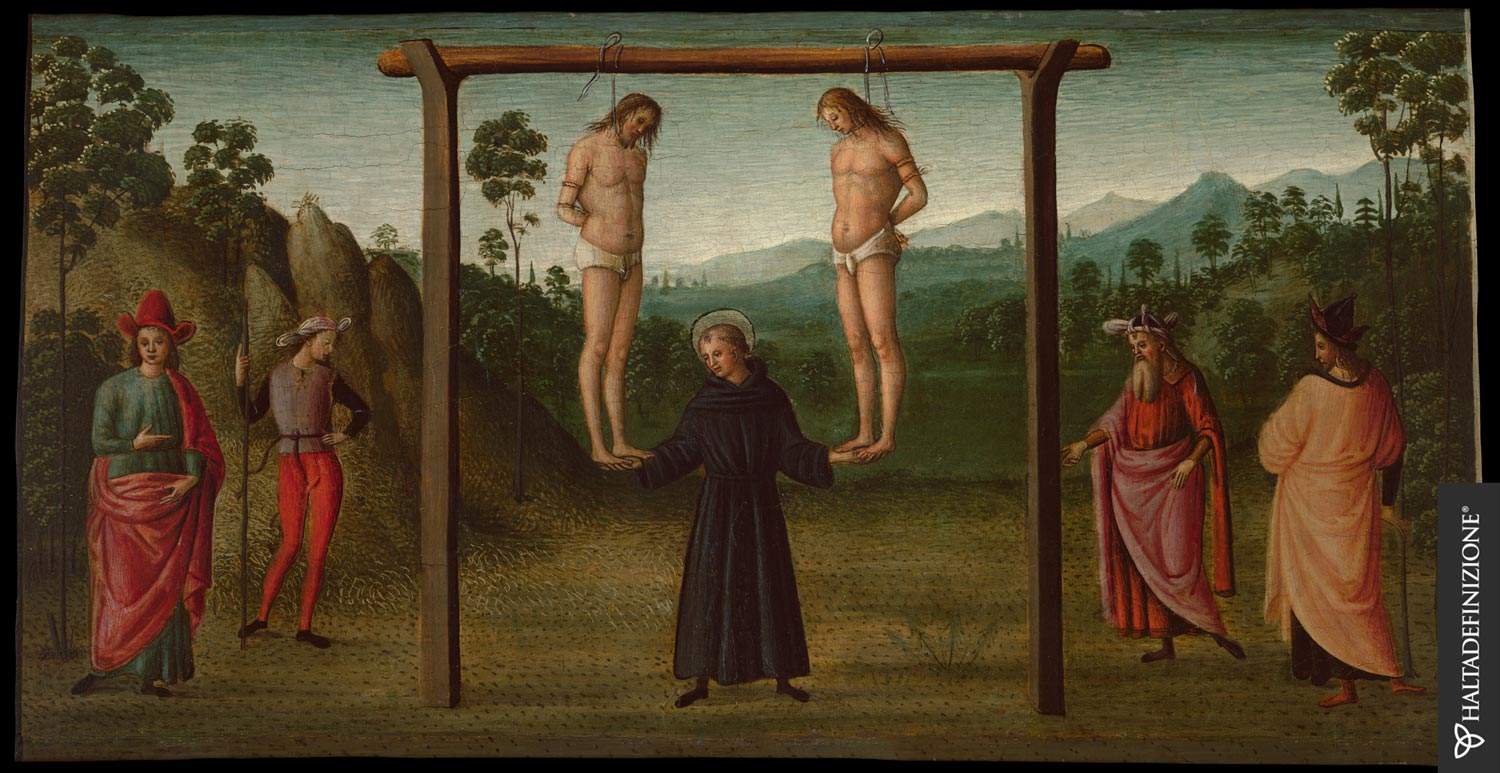Work has begun on digitizing an important panel attributed to Raphael Sanzio (Urbino, 1483 - Rome, 1520), the Miracle of the Hanged, part of the predella of the Baronci Altarpiece, or the Altarpiece of Blessed Nicholas of Tolentino, the result of a collaboration between a very young Raphael and Evangelista da Pian di Meleto (Piandimeleto, c. 1460 - Urbino, 1549), the first known work by the Urbino artist, which has, however, come down to us in fragmentary form. The operation is being conducted by the Regional Directorate of Museums of Tuscany and Haltadefinizione, the tech company of Franco Panini Editore. This is the first time the panel has been acquired in digital format.
The Miracle of the Hanged, which tells the story of two brothers from Osimo, Mizulo and Vanni, unjustly accused of murder, condemned to death and saved by Nicholas of Tolentino who arrives to support their bodies, is kept at the Museo Nazionale di Palazzo Reale in Pisa and has always raised debates about Raphaelesque authorship.
The work came to Pisa’s Palazzo Reale in 1970, following the seizure of the Schiff Giorgini collection: the fragment of the predella had begun to travel through private collections after the dispersal of the altarpiece, which began in 1789 after an earthquake struck Umbria (the painting was kept in the church of Sant’Agostino in Città di Castello) severely damaged the work, which was resected into several parts, now ended up in all corners of the world (and some have not yet been traced). The entire altarpiece is known only from preparatory drawings by Raphael and a copy made in 1791 by Ermenegildo Costantini.
The most recent orientations of critics want the central part of the work (the one with the blessed and the two hanged men) painted by the young Raphael, while the landscape and the outline figures would have been done by another hand. Studies on the panel will find an ally in the digitization of the work in Gigapixel, which will make it possible (thanks to a very high definition reproduction and also a multimedia viewer) to investigate the work in all its details and to do research on the pictorial surface in unprecedented ways.
"The acquisition of the Miracle of the Hanged Men," says Stefano Casciu, director of the Regional Directorate of Museums of Tuscany, “continues the fruitful collaboration already begun between the Regional Directorate of Museums of Tuscany and Haltadefinizionea, which has already made it possible to digitize and make usable online the works of Beato Angelico from the Museum of San Marco in Florence and which today allows the public, in the broadest sense of the term, to appreciate this work down to the smallest detail, not only by proposing its online accessibility but also with a tool that is to all intents and purposes state-of-the-art.”
"The possibility of acquiring and making usable the panel with the Miracle of the Hanged Men at this particularly complicated time due to the health emergency, which has forced museums to revise their programming," says Fabrizio Vallelonga, director of the National Museum of the Royal Palace, “is of particular importance because it it allows us to put to good use and make visible the backstage work carried out during these months of closure and not to miss the opportunity to enhance the work of the Urbino artist on the occasion of the five-hundredth anniversary of his death.”
“Among the extraordinary opportunities that digitization offers,” explains Luca Ponzio, founder of Haltadefinizione, “stands out as a valuable support for scholars and researchers. The image obtained thanks to Gigapixel technology makes it possible to investigate in depth every single brushstroke and the cracks in the pictorial surface, with an accuracy in the order of tens of microns, detecting details not visible to the naked eye. Haltadefinizione has developed acquisition and diagnostic technologies designed for every digitization need, setting very ambitious parameters in terms of quality and resolution of the final images with the utmost respect for the original.”
Image: Raphael (attributed), Nicholas of Tolentino and the hanged (1500-1501; oil on panel; Pisa, Museo Nazionale di Palazzo Reale)
 |
| Raphael's Miracle of the Hanged Men goes digital for the first time |
Warning: the translation into English of the original Italian article was created using automatic tools. We undertake to review all articles, but we do not guarantee the total absence of inaccuracies in the translation due to the program. You can find the original by clicking on the ITA button. If you find any mistake,please contact us.